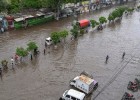Can Pakistan convert its frequent monsoon chaos into sustainable water security?
Monsoon chaos has once again gripped Pakistan, reminiscent of the devastating 2022 floods that submerged one-third of the country and destroyed infrastructure and communities. The worsening urban water crisis further complicates this situation. Cities like Islamabad, Rawalpindi, and Lahore are facing declining groundwater levels due to rapid urbanisation. Instead of recharging aquifers, rainwater rushes into sealed drains and narrow nullahs, many of which are clogged or encroached upon, turning streets into flood zones.
The danger is not merely theoretical. In July 2021, a sudden cloudburst dropped over 100 mm of rain in Islamabad’s E-11 sector, leading to devastating flash floods that resulted in the deaths of two people when their home basements were inundated. Satellite imagery later confirmed that the illegal narrowing of the natural nullah by housing developments had blocked water flow, worsening the flooding.
The human cost of this monsoon continues to rise. Reuters reports that Punjab experienced at least 63 more deaths in a single day, bringing the national total to 159. Al Jazeera confirms that fatalities have now surpassed 180, with children tragically making up over half of the deceased.
Northern Pakistan has not been spared either. In Gilgit-Baltistan, glacial lake outburst floods have destroyed villages and blocked tourist routes, while flash........






















 Toi Staff
Toi Staff Gideon Levy
Gideon Levy Donald Earl Collins
Donald Earl Collins Tarik Cyril Amar
Tarik Cyril Amar Eric Reinhart
Eric Reinhart Yara Hawari
Yara Hawari Belen Fernandez
Belen Fernandez Sabine Sterk
Sabine Sterk Marcel Fürstenau
Marcel Fürstenau Rachel Marsden
Rachel Marsden Stefano Lusa
Stefano Lusa
